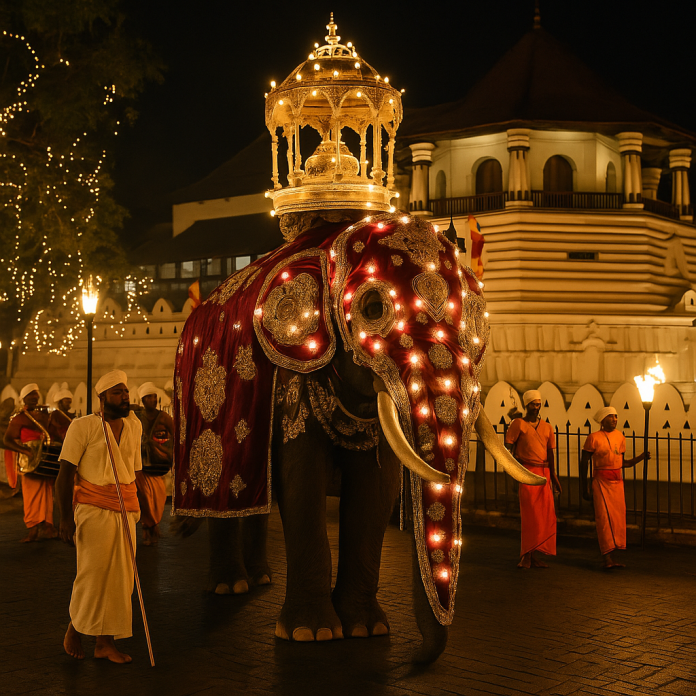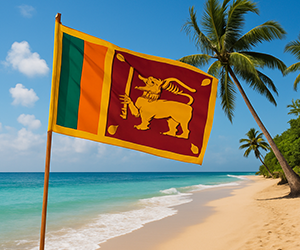Introduction
Every year, in the historic city of Kandy, a spectacular religious and cultural event transforms the night sky into a dazzling display of lights, music, and tradition—the Sri Dalada Perahera, also known as the Esala Perahera. This centuries-old Buddhist procession is one of the grandest festivals in Sri Lanka, held in honor of the Sacred Tooth Relic of Lord Buddha, housed in the Sri Dalada Maligawa (Temple of the Tooth Relic).
The festival is a fusion of devotion, art, culture, and heritage, celebrated not only by Buddhists but by people of all ethnic and religious backgrounds. This comprehensive article delves into the rich history, religious significance, ritualistic grandeur, and modern-day impact of the Kandy Dalada Perahera.
The Historical Legacy of the Sri Dalada Perahera
Origin of the Sacred Tooth Relic
The Sacred Tooth Relic was brought to Sri Lanka from India in the 4th century AD by Princess Hemamali and Prince Dantha. According to legend, the Tooth Relic was hidden in the princess’s hair to protect it from enemies. Upon arrival in Anuradhapura, it became a revered object of Buddhist veneration and later moved across various capitals before being enshrined in Kandy during the reign of King Vimaladharmasuriya I.
Establishment of the Perahera
The Dalada Perahera was established as a ceremonial tribute to the Tooth Relic during the Kandyan Kingdom, where the king was considered the protector of the relic. The Esala Perahera, held during the month of Esala (July–August), was meant to invoke the blessings of the deities for rainfall and fertility of the land.
The Temple of the Tooth Relic – Sri Dalada Maligawa
Situated beside the Kandy Lake, the Sri Dalada Maligawa is a sacred temple complex that serves as the custodian of the Tooth Relic. Its majestic architecture, golden canopy, and intricate carvings symbolize spiritual reverence and national pride. It is also a UNESCO World Heritage Site and attracts thousands of pilgrims and tourists annually.
The Structure and Phases of the Perahera
The Kandy Esala Perahera is not a one-day event but a ten-day spiritual and cultural journey, which includes:
1. Kap Situweema (Planting of the Kap)
This marks the beginning of the festival, where a sacred jackfruit tree (Kap) is planted at each of the four devalayas (shrines) representing Natha, Vishnu, Kataragama, and Pattini gods. It symbolizes the invocation of divine blessings.
2. Devale Peraheras
For the first five nights, individual processions from each devalaya are held within their premises. These are known as the Devale Peraheras, performed to prepare spiritually for the grand procession.
3. Kumbal Perahera
The first public procession of the main Perahera, held for five nights. It is slightly smaller in scale and includes elephants, drummers, dancers, and torchbearers, helping to acclimate the young elephants and performers.
4. Randoli Perahera
The Randoli Perahera is the most opulent and grand phase of the festival. It showcases:
- The majestic tusker carrying the casket of the Sacred Relic
- Whip crackers, fire dancers, and traditional drummers
- Kandyan dancers, flag bearers, and sword carriers
- Randoli (ornate palanquins), representing ancient queens’ carriages
Each night, the procession becomes more elaborate, culminating in a magnificent final parade.
5. Diya Kepeema (Water Cutting Ceremony)
Held at the Mahaweli River, this ritual marks the symbolic cleansing and conclusion of the festival. A sword is dipped into the river to separate the sacred waters, and part of it is taken back to the temple to be kept until the next year.
Cultural and Religious Symbolism
Devotion and Faith
For Buddhists, the Tooth Relic is the most sacred object, symbolizing the living presence of the Buddha. Participating in or even witnessing the Perahera is considered an act of merit and spiritual fulfillment.
Artistic Expression
The Perahera is a vivid expression of Sri Lankan performing arts, especially Kandyan dance, traditional drumming, and ritualistic movements that have been preserved through generations.
Multifaith Participation
Though rooted in Buddhist tradition, the Perahera incorporates Hindu shrines and their rituals, demonstrating the interwoven spiritual tapestry of Sri Lanka’s culture.
Highlights of the Dalada Perahera
- The Maligawa Tusker carrying the golden casket (Karanduwa)
- Fireball twirlers and whip dancers leading the procession
- Torch-lit elephants adorned with colorful silk garments
- Cultural troupes from across Sri Lanka showcasing regional dance forms
- The triumphant beating of the “Geta Beraya” (ceremonial drum)
- Children’s Perahera held during the day for younger audiences
The Role of Elephants in the Perahera
Elephants are central to the Perahera, especially the lead tusker who bears the golden casket. These majestic animals are adorned with lights, silk, and regalia, and trained for years to participate in the sacred procession. Their role is both spiritual and cultural.
Note: In recent years, there has been growing attention to ethical treatment of elephants and efforts to ensure their well-being during the event.
Tourist Experience and Travel Tips
When and Where to Watch
- Best time to visit: Last five nights of the Randoli Perahera
- Ideal spots: Temple Street, D.S. Senanayake Street, and Queen’s Hotel area
- Seating: Book VIP seats early via online or through hotels in Kandy
Photography and Filming
Photography is allowed but with respect. Flash should be avoided during sacred parts of the procession. Tripods are discouraged in crowded areas.
What to Wear
Dress modestly and respectfully, as this is a religious event. White or light-colored clothing is recommended.
Accommodations
Kandy is filled with boutique hotels, heritage bungalows, and modern stays. Early booking is essential as hotels fill up quickly during Perahera season.
Media and Global Attention
The Dalada Perahera is widely covered on national television, YouTube, and social media, drawing millions of viewers globally. Its reputation as one of the greatest religious processions in Asia has made it a bucket-list experience for travelers, photographers, and culture enthusiasts.
Economic and Social Impact
Boost to Tourism
The Perahera significantly boosts local tourism, providing income for hoteliers, restaurants, souvenir shops, and transport services. It also helps to promote Sri Lankan heritage globally.
Community Engagement
From craftsmen designing elephant garments to dancers training for months, the entire community engages in the Perahera, making it a truly people-powered event.
Challenges and Conservation
- Crowd management and safety in recent years have become crucial.
- Animal rights activists continue to campaign for better treatment of elephants.
- The government and temple authorities have introduced sustainability and conservation measures to ensure the festival remains eco-friendly and humane.
Digital Era and Modern Perahera
In the digital age, the Dalada Perahera has embraced live streaming, social media campaigns, and virtual experiences. This helps people around the world feel connected to the spiritual aura of Kandy’s sacred city.
Conclusion
The Sri Dalada Perahera in Kandy is not merely a festival—it’s a symphony of faith, culture, and unity. It celebrates the enduring reverence for the Sacred Tooth Relic of Lord Buddha while showcasing the richness of Sri Lankan tradition. For locals, it is a time of spiritual upliftment and community pride. For travelers, it offers an unforgettable cultural immersion into one of the oldest living traditions in the world.
Whether you are drawn by the majestic elephants, the rhythmic beats of traditional drums, or the spiritual serenity of the Temple of the Tooth, the Dalada Perahera is a journey into the very soul of Sri Lanka.




